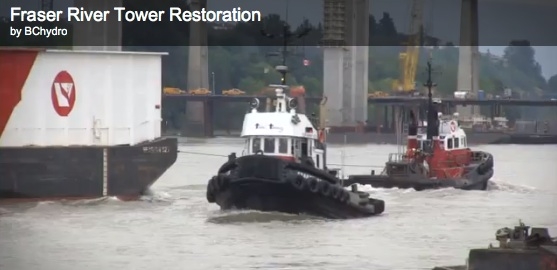
News
Erosion causes a towering problem – BC Hydro engineers come up with a solution
January 4, 2012 | By Anthony Capkun

January 3, 2012 – On a quiet summer evening just over six months ago, an extremely tall and heavy 230-kV transmission tower unexpectedly fell into the Fraser River just west of the Port Mann Bridge.
SCROLL DOWN FOR VIDEO
It shut off the lights for about 25,000 BC Hydro customers in Surrey and, due to unusually high water flows and unexpected erosion on the banks of the river, an adjacent 500-kV tower started to lean over the water and was also at risk of falling.
“With two major transmission lines out of commission, there was a lot of pressure to create and execute a feasible solution to get at least one of the transmission lines up and running again before the winter storm season,” recalls Laura Erven, a senior manager with BC Hydro’s power transmission and distribution group.
While BC Hydro crews restored power to customers affected by the first tower collapse—within two hours for all but a few hundred customers—the work had just begun. It took months of brainstorming and planning before BC Hydro was able to safely reenergize both the 230-kV and 500-kV transmission lines before the winter storm season.
Engineers and field crews worked around the clock to ensure Surrey customers would have reliable power during the coldest months of the year when electricity demand is at its peak.
The unpredictable nature of the Fraser River last summer imposed a significant challenge to restoring and reenergizing both the 500-kV and 230-kV transmission lines. The river’s water level was at a record high, and the strong current caused significant erosion and sloughing of the south bank where the 230-kV tower once stood.
After extensive geotechnical studies and environmental approvals, BC Hydro decided to leave the fallen 230-kV tower in the water to increase the stability of the unsteady Fraser River shoreline. The tower was quickly covered in silt by the active river and combined with rip rap—rock and rubble placed to protect the shoreline—to become part of the Fraser River bank.
During this time, BC Hydro stabilized the leaning 500-kV tower. Eight 100-ft-high steel piles were driven into the river bed and over 54,000 tonnes of rip rap placed around the base of the tower.
Crews were able to secure and stabilize the 500-kV tower despite the aggressive nature of the Fraser River. The 500-kV line was reenergized in early September.
The solution: Longer lines, eliminating a tower
Facing tight timelines and a potentially recurring problem of river bank erosion, BC Hydro engineers came to a creative solution for restringing the 230-kV line.
By using high-tension, low-sag and significantly longer transmission lines, BC Hydro could replace the tower conductors without rebuilding the fallen tower. In effect, the longer lines would be strung to a tower far up and away from the river bank, eliminating the use of a tower on the river bank.
“By not replacing the [230-kV] tower on the river that fell and using the stronger, taller towers [that will support the new high-tension cables], we’re mitigating the likelihood of this event ever reoccurring,” said BC Hydro’s Greg Reimer, vice-president of transmission and distribution.
Bringing in the helicopters
On November 19, helicopters flew five industrial guide-ropes, one at a time, from the tower on the north side of the Fraser River to the second 230-kV tower inland on the south side, beyond the CN railway yard.
After the helicopter strung the guide-ropes, the transmission wires were pulled across the Fraser River using a tension machine. The 230-kV line was successfully reenergized in December.
“With these special high-tension conductors you can pull them tighter, preventing the transmission line from sagging over a long distance,” said Lana Gilpin-Jackson, a senior engineer with BC Hydro.
After storm season, the 500-kV tower will be removed from the Fraser River’s unstable shore and the same solution—employing longer lines to effectively eliminate use of a tower on an unstable shore—will be used for the 230-kV line.
— With files from BC Hydro
” frameborder=”0″ allowfullscreen>
Print this page